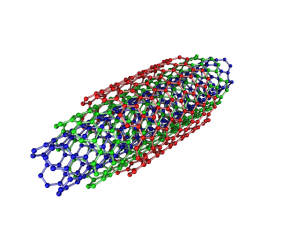New Evidence of Mesothelioma Risk from Inhaled Multiwalled Carbon Nanotubes
 Scientists have long suspected that inhaling multi-walled carbon nanotubes could cause malignant mesothelioma, but a new Japanese study appears to prove that it does – at least in rats.
Scientists have long suspected that inhaling multi-walled carbon nanotubes could cause malignant mesothelioma, but a new Japanese study appears to prove that it does – at least in rats.
Asbestos, a naturally-occurring mineral once widely used as an insulator and building product additive, remains the number one cause of both pleural and peritoneal mesothelioma worldwide.
But researchers have theorized that the same things that make asbestos fibers so carcinogenic – their size, shape, and chemical makeup – might make other similarly-shaped molecules like carbon nanotubes dangerous, too.
Multi-walled Carbon Nanotubes
Multi-walled carbon nanotubes (MWCNTs) are man-made cylindrical molecules of carbon arranged in a concentric pattern. Because of their extraordinary strength and thermal conductivity, MWCNTs are used in electronics and optics, as well as to strengthen carbon fibers baseball bats, golf clubs and car parts.
Like asbestos fibers, MWCNTs are long and thin which, some theorize, could cause them to become stuck in lung tissue in the same way that asbestos fibers become stuck. Over time, the body’s reaction to these biopersistent fibers could trigger cellular changes that lead to mesothelioma.
The Link Between Mesothelioma and MWCNTs
Researchers already knew that MWCNTs could be dangerous. Previous experiments have shown that rats injected with MWCNTs can develop mesothelioma.
But the question for a team of scientists from several Japanese Universities was whether or not MWCNTs could do the same thing if they were just inhaled, the way a worker might accidentally inhale them on the job. Unfortunately, the answer appears to be yes.
When a solution containing MWCNTs was sprayed through the tracheas directly into the lungs of 38 rats, six of them developed mesothelioma and 14 developed lung cancer. The results led molecular toxicologist Masumi Suzui to conclude, “Administration of MWCNT to the lung in the rat induces malignant mesothelioma and lung tumors.”
Protecting Workers from Malignant Mesothelioma
Because there is so little data on the safety of carbon nanotubes in humans, companies that use them and government agencies have primarily based their safety recommendations on the results of animal studies like the current one.
Several international agencies, including the British Health and Safety Executive and the US National Institute of Occupational Safety and Health have published strategies for controlling workplace exposures to carbon nanotubes and implementing medical surveillance programs.
Until the hazards posed by these molecules are better understood, those who work around these materials should learn from the experience of asbestos workers and exercise caution to minimize the risk of malignant mesothelioma or other health problems.
Sources:
Suzui, M, et al, “Multiwalled carbon nanotubes intratracheally instilled in the rat lung induce development of pleural malignant mesothelioma and lung tumors:, April 21, 2016, Cancer Science, Epub ahead of print
“Current Intelligence Bulletin 65: Occupational Exposure to Carbon Nanotubes and Nanofibers”, National Institute for Occupational Safety and Health, Centers for Disease Control and Prevention website





